2013 Peugeot 508 Hybrid dashboard
[x] Cancel search: dashboardPage 29 of 340
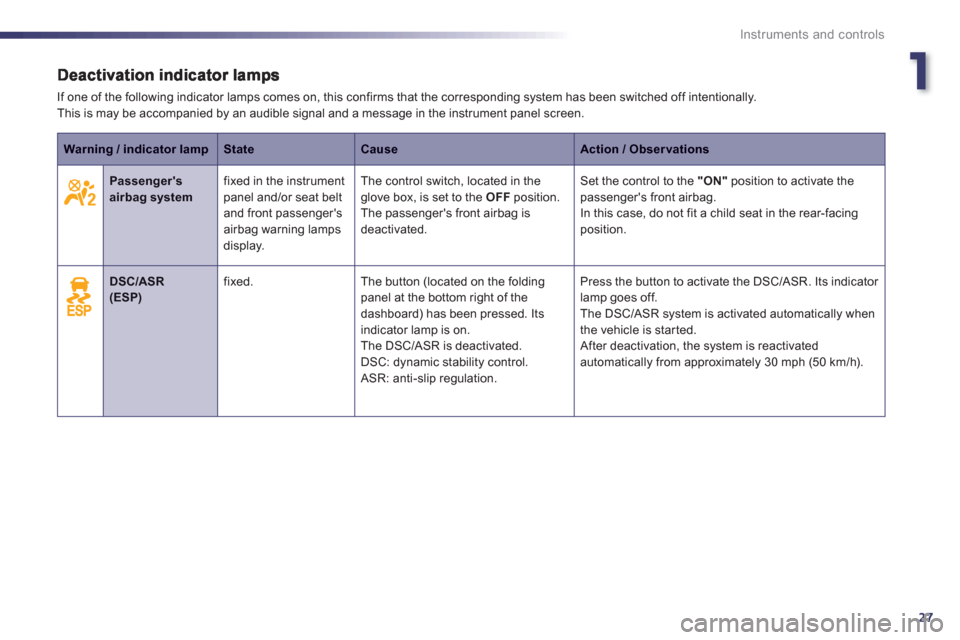
1
27
Instruments and controls
If one of the following indicator lamps comes on, this confirms that the corresponding system has been switched off intentionally.This is may be accompanied by an audible signal and a message in the instrument panel screen.
Warning / indicator lampStateCauseAction / Observations
Passenger's airbag system fixed in the instrument
panel and/or seat belt
and front passen
ger's
airbag warning lamps
display.The control switch, located in the
glove box, is set to the OFF
position.
The passenger's front airbag is deactivated.
Set the control to the "ON"position to activate the passenger's front airbag.
In this case, do not fit a child seat in the rear-facing position.
DSC/ASR(ESP)
fixed. The button (located on the foldingpanel at the bottom right of the
dashboard) has been pressed. Its
indicator lamp is on.
The D
SC/ASR is deactivated.
DSC: dynamic stability control.
ASR: anti-slip regulation. Press the button to activate the DSC/ASR. Its indicator
lamp
goes off.
The DSC/ASR system is activated automatically when
the vehicle is started.
After deactivation, the system is reactivated
automatically from approximately 30 mph (50 km/h).
Page 89 of 340
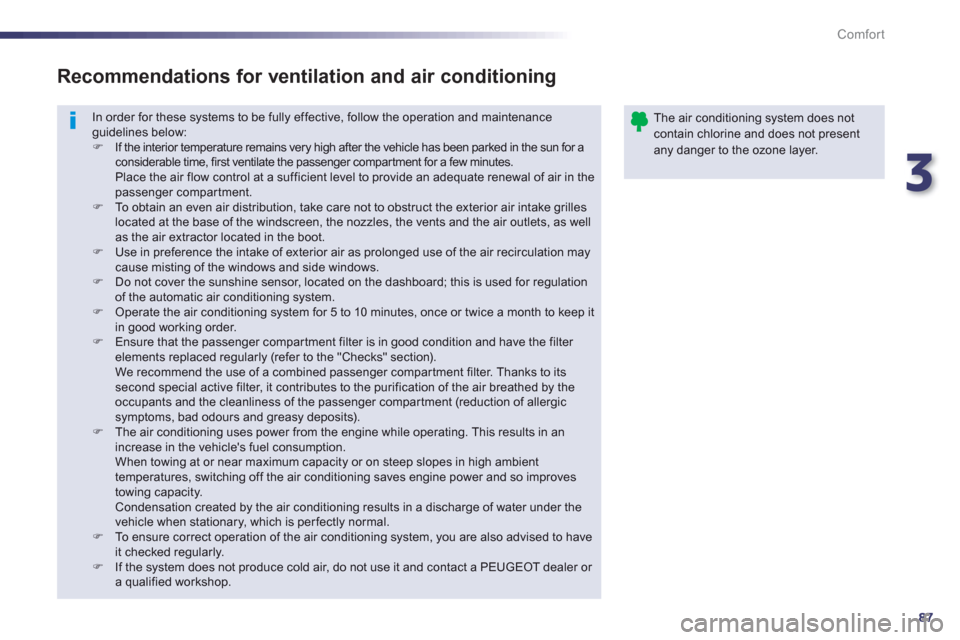
3
87
Comfort
In order for these systems to be fully effective, follow the operation and maintenance guidelines below: F
If the interior temperature remains very high after the vehicle has been parked in the sun for a considerable time, first ventilate the passenger compar tment for a few minutes. Place the air flow control at a sufficient level to provide an adequate renewal of air in the passenger compartment.F
To obtain an even air distribution, take care not to obstruct the exterior air intake grilles located at the base of the windscreen, the nozzles, the vents and the air outlets, as wellas the air extractor located in the boot. F
Use in preference the intake of exterior air as prolonged use of the air recirculation maycause misting of the windows and side windows.F
Do not cover the sunshine sensor, located on the dashboard; this is used for regulation of the automatic air conditioning system.F
Operate the air conditioning system for 5 to 10 minutes, once or twice a month to keep itin good working order. F
Ensure that the passenger compar tment filter is in good condition and have the filter elements replaced regularly (refer to the "Checks" section). We recommend the use of a combined passenger compartment filter. Thanks to its second special active filter, it contributes to the purification of the air breathed by the occupants and the cleanliness of the passenger compartment (reduction of allergic symptoms, bad odours and greasy deposits).F
The air conditioning uses power from the engine while operating. This results in anincrease in the vehicle's fuel consumption. When towing at or near maximum capacity or on steep slopes in high ambient temperatures, switching off the air conditioning saves engine power and so improvestowing capacity. Condensation created by the air conditioning results in a discharge of water under thevehicle when stationary, which is per fectly normal.F
To ensure correct operation of the air conditioning system, you are also advised to haveit checked regularly.F
If the system does not produce cold air, do not use it and contact a PEUGEOT dealer or a qualified workshop.
Recommendations for ventilation and air conditioning
The air conditioning system does notcontain chlorine and does not present any danger to the ozone layer.
Page 103 of 340
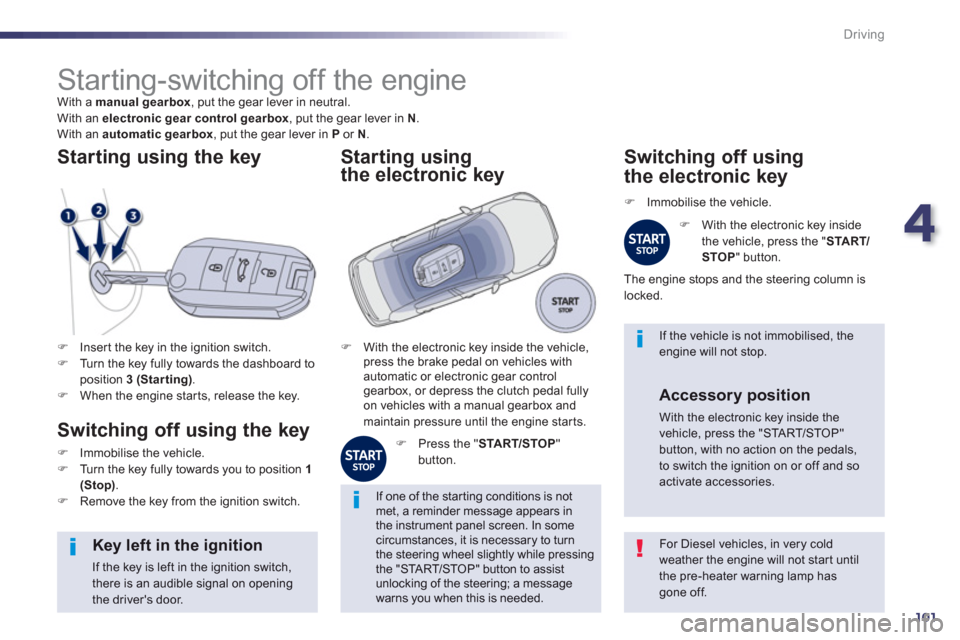
4
101
Driving
Starting-switching off the engine
With a manual gearbox
, put the gear lever in neutral.
With an electronic gear control gearbox, put the gear lever in N.
With an automatic gearbox
, put the gear lever in P
or N
.
FInser t the key in the ignition switch. FTurn the key fully towards the dashboard toposition 3 (Starting).FWhen the engine star ts, release the key.
Starting using the key
Switching off using the key
FImmobilise the vehicle. FTurn the key fully towards you to position 1(Stop)
. FRemove the key from the ignition switch.
For Diesel vehicles, in very cold weather the engine will not star t until the pre-heater warning lamp has
gone off.
Key left in the ignition
If the key is left in the ignition switch,there is an audible signal on opening the driver's door.
If one of the star ting conditions is not met, a reminder message appears inthe instrument panel screen. In somecircumstances, it is necessary to turn the steering wheel slightly while pressing the "STA R T/STOP" button to assist unlocking of the steering; a message warns you when this is needed.
If the vehicle is not immobilised, theengine will not stop. FWith the electronic key inside the vehicle,
press the brake pedal on vehicles with
automatic or electronic
gear controlgearbox, or depress the clutch pedal fully
on vehicles with a manual gearbox and
maintain pressure until the engine star ts.
Starting using
the electronic key
ggg
FPress the " STA R T/STOP"button.
Switching off using
the electronic key
F
Immobilise the vehicle.
F
With the electronic key inside
the vehicle, press the "START/
STOP"
button.
The en
gine stops and the steering column islocked.
Accessory position
With the electronic key inside the vehicle, press the "STA R T/STOP"button, with no action on the pedals, to switch the ignition on or off and so activate accessories.
Page 176 of 340

174
Safety
Airbags
System designed to maximise the safety of the
occupants (with the exception of the rear centrepassenger) in the event of violent collisions.
It supplements the action of the force-limiting seat belts (with the exception of the rear centrepassenger).
If a collision occurs, the electronic detectors record and analyse the front and side impacts sustained in the impact detection zones:
- in the case of a serious impact, the airbagsare deployed instantly and protect the
occupants of the vehicle (with the exception
of the rear centre passenger); immediately after the impact, the airbags deflate rapidlyso that they do not hinder visibility or the
exit of the occupants,
- in the case of a minor or rear impact or incer tain roll-over conditions, the airbags
will not be deployed; the seat belt alone is
sufficient to provide optimum protection in
th
ese situations.
The airbags do not operate when the ignition is switched off. This equipment will only deploy once. If a second impact occurs (during thesame or a subsequent accident), theairbag will not be deployed again.
Deployment of the airbag(s) is accompanied by a slight emission of harmless smoke and a noise, due to theactivation of the pyrotechnic cartridgeincorporated in the system.This smoke is not harmful, but sensitiveindividuals may experience slight irritation. The noise of the detonation may result in a slight loss of hearing for a shorttime.
Impact detection zones
A.
Front impact zone. B.
Side impact zone.
Front airbags
Deployment
The airbags are deployed simultaneously, unless
the passenger's front airbag is deactivated, in the event of a serious front impact to all or part of thefront impact zone A , in the longitudinal centreline of
the vehicle on a horizontal plane and directed from
the front to the rear of the vehicle.
The front airbag inflates between the thorax and head of the front occupant of the vehicle and thesteering wheel, driver's side, and the dashboard,passenger's side to cushion their forward movement.
System which protects the driver and frontpassenger in the event of a serious front impact
in order to limit the risk of injury to the head and
thorax.
The driver's airbag is fitted in the centre of the steering wheel; the front passenger's airbag isfitted in the dashboard above the glove box.
Page 179 of 340
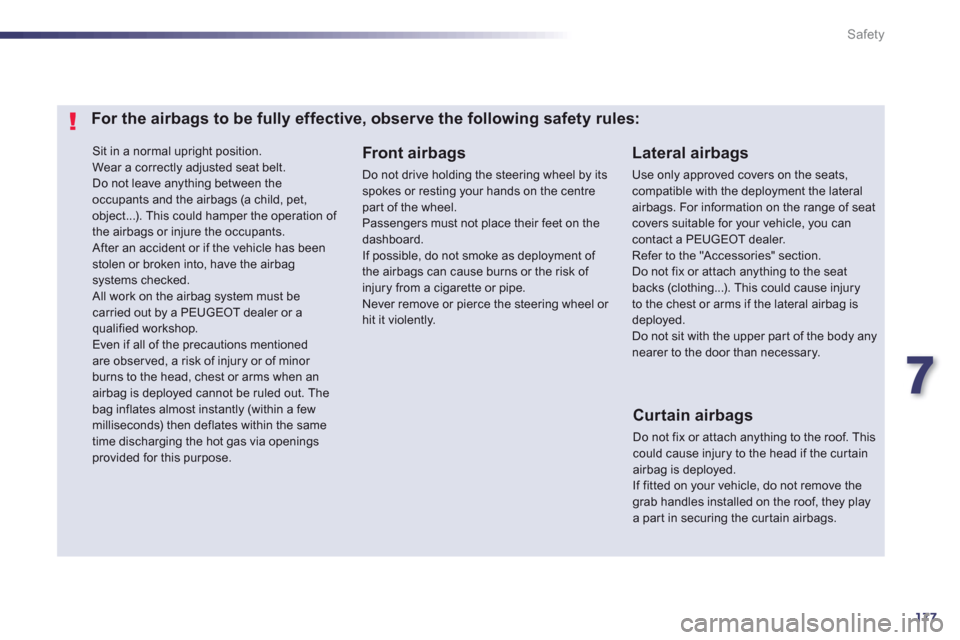
7
177
Safety
Sit in a normal upright position.
Wear a correctly adjusted seat belt.
Do not leave anything between theoccupants and the airbags (a child, pet, object...). This could hamper the operation of the airbags or injure the occupants. After an accident or if the vehicle has beenstolen or broken into, have the airbagsystems checked. All work on the airbag system must be carried out by a PEUGEOT dealer or a qualified workshop.
Even if all of the precautions mentionedare obser ved, a risk of injury or of minor burns to the head, chest or arms when an airbag is deployed cannot be ruled out. Thebag inflates almost instantly (within a fewmilliseconds) then deflates within the same
time discharging the hot gas via openings provided for this purpose.
Lateral airbags
Use only approved covers on the seats, compatible with the deployment the lateralairbags. For information on the range of seatcovers suitable for your vehicle, you can contact a PEUGEOT dealer. Refer to the "Accessories" section.Do not fix or attach anything to the seatbacks (clothing...). This could cause injuryto the chest or arms if the lateral airbag isdeployed.Do not sit with the upper par t of the body anynearer to the door than necessary.
Front airbags
Do not drive holding the steering wheel by itsspokes or resting your hands on the centre part of the wheel.
Passengers must not place their feet on thedashboard.
If possible, do not smoke as deployment of the airbags can cause burns or the risk of injury from a cigarette or pipe.
Never remove or pierce the steering wheel or hit it violently.
For the airbags to be fully effective, observe the following safety rules:
Curtain airbags
Do not fix or attach anything to the roof. This could cause injury to the head if the cur tain airbag is deployed. If fitted on your vehicle, do not remove thegrab handles installed on the roof, they play a part in securing the cur tain airbags.
Page 204 of 340

202
Practical information
Dashboard fuses
The fusebox is placed in the lower dashboard (right-hand side).
Access to the fuses
FOpen the folding panel then apply pressure
to bypass the stops.
Fuse N°Rating (A)Functions
F
315 Driver's electric window panel, 12 V socket for rear seats.
F415
12 V socket in boot.
F5
30 One-touch rear window.
F
630 One-touch front window.
F1
120
Trailer unit.
F1220
Audio amplifier.
F1
520
Panoramic sunroof blind (SW).
F1
65
Driver's electric window switch panel.
Page 219 of 340
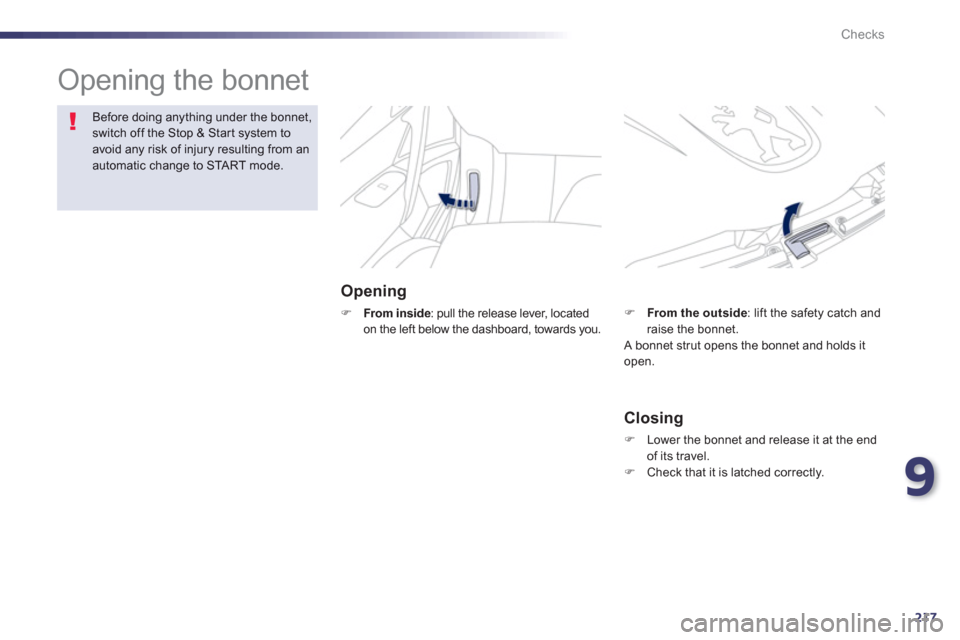
9
217
Checks
Opening the bonnet
Opening
FFrom inside: pull the release lever, located
on the left below the dashboard, towards you.
Before doing anything under the bonnet,switch off the Stop & Start system toavoid any risk of injury resulting from anautomatic change to STA R T m o d e .
Closing
F
Lower the bonnet and release it at the endof its travel. F
Check that it is latched correctly.
FFrom the outside: lift the safety catch and
raise the bonnet.
A bonnet strut opens the bonnet and holds itopen.
Page 243 of 340
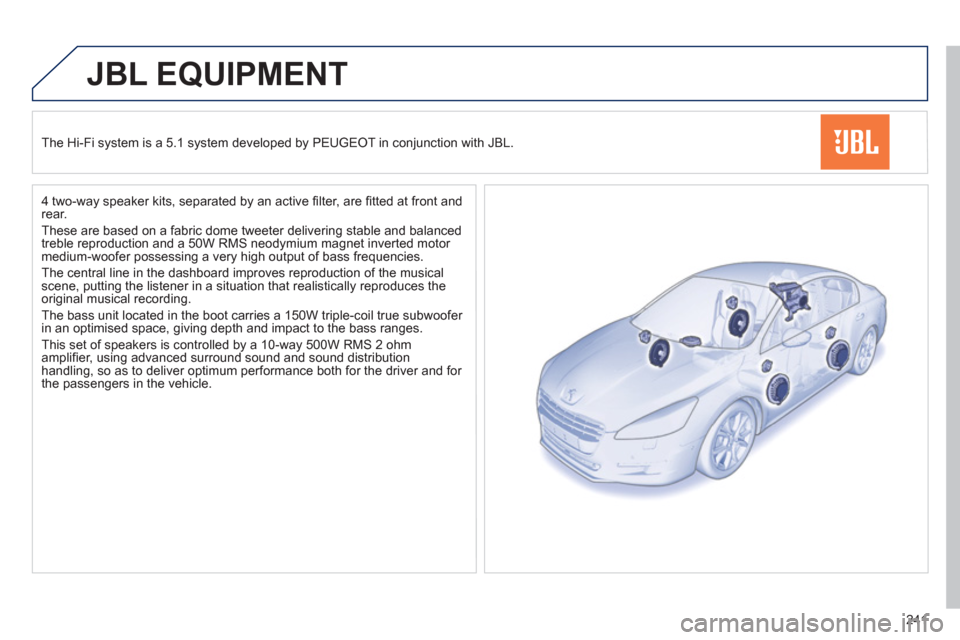
241
JBL EQUIPMENT
The Hi-Fi system is a 5.1 system developed by PEUGEOT in conjunction with JBL.
4 two-wa
y speaker kits, separated by an active fi lter, are fi tted at front andrear.
These are based on a fabric dome tweeter deliverin
g stable and balanced
treble reproduction and a 50W RMS neodymium magnet inverted motor medium-woofer possessing a very high output of bass frequencies.
The central line in the dashboard improves reproduction o
f the musicalscene, putting the listener in a situation that realistically reproduces theoriginal musical recording.
The bass unit located in the boot carries a 150W tri
ple-coil true subwoofer
in an optimised space, giving depth and impact to the bass ranges.
This set of speakers is controlled b
y a 10-way 500W RMS 2 ohm
amplifi er, using advanced surround sound and sound distribution handling, so as to deliver optimum performance both for the driver and for
the passengers in the vehicle.